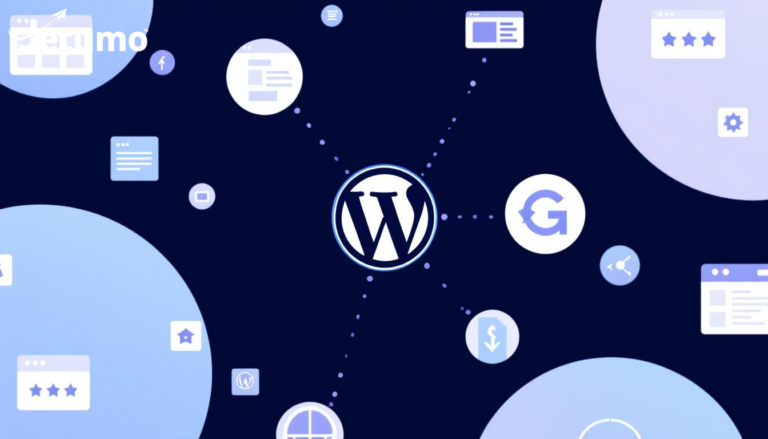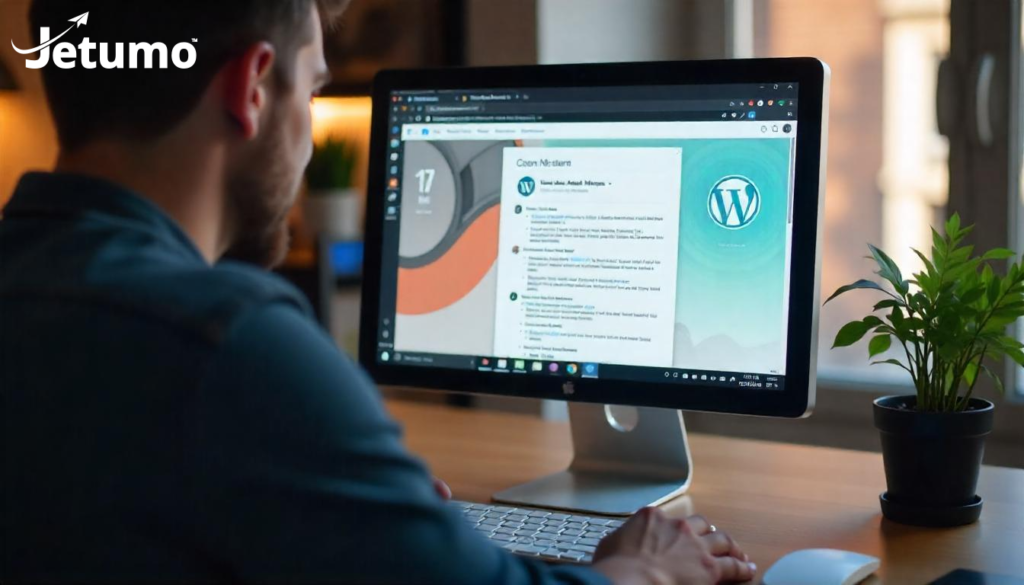Managing multiple WordPress websites for your business, clients, or various projects can quickly become overwhelming. Between juggling separate hosting accounts, managing individual WordPress installations, and handling domain configurations, the administrative burden grows exponentially with each new site.
WordPress multisite hosting offers a streamlined solution that transforms this chaos into organized efficiency. Instead of managing separate WordPress installations, you can run multiple WordPress websites from a single WordPress installation, all controlled through one centralized dashboard.
Whether you’re a web developer managing client sites, a business owner with multiple brands, or an agency handling dozens of websites, WordPress multisite hosting can save you significant time and money while simplifying your entire website management workflow. This guide covers everything you need to know about WordPress multisite hosting, from setup requirements to choosing the right hosting provider.
What is WordPress Multisite Hosting and How Does It Work?
WordPress multisite hosting is a hosting solution specifically optimized for WordPress’s multisite feature, which allows you to create and manage multiple WordPress websites from a single WordPress installation. Think of it as having one WordPress “control center” that manages multiple website “branches.”
When you enable WordPress multisite, you create a network of sites that share the same WordPress core files, database, and administrative interface. Each site in your multisite network can have its own domain name, content, users, and customizations while sharing the underlying WordPress infrastructure.
The WordPress Multisite Architecture
A WordPress multisite network operates differently from individual WordPress installations. Instead of separate WordPress files for each site, multisite creates:
- Shared WordPress core files that all sites in the network use
- Individual database tables for each site (wp_2_posts, wp_3_posts, etc.)
- Network-wide user management where users can access multiple sites
- Centralized plugin and theme management across all network sites
- Single administrative dashboard for managing the entire network
This architecture provides significant advantages for businesses managing multiple websites, especially when combined with proper WordPress hosting requirements that support multisite functionality.
Why Choose WordPress Multisite Hosting Over Individual Sites?
The decision between WordPress multisite hosting and individual site management depends on your specific needs, but multisite offers compelling advantages for many situations.
Cost Efficiency: Instead of paying for separate hosting accounts for each website, WordPress multisite hosting allows you to run multiple sites on a single hosting plan. This can result in significant cost savings, especially for agencies managing numerous client websites.
Simplified Management: Managing WordPress updates, security patches, and plugin updates across multiple individual sites is time-consuming. With multisite, you handle these tasks once for the entire network, dramatically reducing administrative overhead.
Centralized User Management: If you need users to access multiple sites, WordPress multisite makes this seamless. Users can have different roles on different sites within the network, all managed from one location.
Consistent Branding and Standards: Maintaining consistent themes, plugins, and configurations across multiple sites becomes much easier when they’re all part of the same network. You can enforce standards while still allowing site-specific customizations.
However, multisite isn’t always the right choice. High-traffic sites might perform better with dedicated hosting resources, and sites with completely different purposes might benefit from separate hosting environments. Consider your specific WordPress performance optimization needs when making this decision.
What Are the Technical Requirements for WordPress Multisite Hosting?
WordPress multisite hosting requires more robust server resources than standard WordPress hosting. Understanding these requirements is crucial for choosing the right hosting provider and ensuring optimal performance.
Server Resource Requirements
Memory (RAM) Needs: WordPress multisite networks require significantly more RAM than single-site installations. A single WordPress site might run adequately on 1GB of RAM, but multisite networks typically need:
- 2GB RAM minimum for networks with 2-5 sites
- 4GB+ RAM for networks with 6-15 sites
- 8GB+ RAM for larger networks with 16+ sites
Processing Power: Each site in your network shares server resources. You’ll need sufficient CPU power to handle concurrent traffic across multiple sites without performance degradation.
Storage Considerations: While multisite shares core WordPress files, each site requires storage for media uploads, individual database content, and site-specific customizations. Plan for adequate storage that can grow with your network.
Database Performance Requirements
WordPress multisite uses a more complex database structure than single-site installations. Each site gets its own database tables while sharing some network-wide tables. This requires:
- Optimized database configurations for handling multiple site queries
- Sufficient database connections to handle concurrent site access
- Regular database maintenance to prevent performance issues
Your hosting provider should understand these requirements and offer WordPress security hardening measures that work with multisite architecture.
How Do You Set Up WordPress Multisite on Your Hosting?
Setting up WordPress multisite requires careful planning and proper hosting configuration. The process involves several steps that must be completed in the correct order.
Pre-Setup Planning
Before enabling multisite, decide on your network structure:
Subdomain Network: Sites appear as site1.yourdomain.com, site2.yourdomain.com. This requires wildcard DNS configuration from your hosting provider and is more flexible for different site purposes.
Subdirectory Network: Sites appear as yourdomain.com/site1, yourdomain.com/site2. This is easier to set up on most hosting platforms and better for closely related sites.
Configuration Steps
Database Backup: Always create a complete backup before enabling multisite. This ensures you can restore your site if something goes wrong during setup.
WordPress Configuration: Edit your wp-config.php file to enable multisite by adding the required configuration lines. This step must be done carefully to avoid breaking your existing site.
Network Setup: Use WordPress’s network setup tool to configure your multisite network. This creates the necessary database tables and configures the network settings.
File Permissions: Ensure proper file permissions are set for network operations. Your hosting provider should support the file system requirements for multisite.
The setup process can be complex, which is why many users prefer managed hosting solutions that handle these technical details. Consider WordPress troubleshooting resources if you encounter issues during setup.
What Should You Look for in a WordPress Multisite Hosting Provider?
Not all hosting providers are equipped to handle WordPress multisite networks effectively. Choosing the right provider is crucial for your network’s success.
Essential Hosting Features
Adequate Server Resources: Your hosting provider should offer sufficient RAM, CPU power, and storage for your multisite network. Avoid budget hosting providers that overcrowd servers, as this can severely impact multisite performance.
Multisite-Specific Support: Look for providers whose support staff understand WordPress multisite architecture and can assist with network-specific issues. Generic hosting support often struggles with multisite problems.
Scalability Options: Choose hosting that allows you to easily upgrade resources as your network grows. Your multisite network should be able to expand without requiring complex migrations.
Performance Optimization: The best hosting providers offer server-level optimizations specifically for WordPress, including caching solutions that work with multisite networks.
Server Technology Considerations
Storage Type: NVMe SSD storage provides significantly better performance for WordPress multisite networks compared to traditional storage. The improved database query performance is particularly noticeable in multisite environments.
Web Server Technology: Modern web servers like OpenLiteSpeed with LSCache can provide better performance for WordPress multisite networks compared to traditional Apache configurations.
Control Panel: Modern control panels like ISPmanager 6 offer cleaner, more intuitive interfaces for managing multisite networks compared to older alternatives like cPanel.
These considerations align with Sweet Spot Hosting principles that emphasize better performance infrastructure at reasonable prices.
How Do You Manage Multiple WordPress Sites Efficiently?
Once your WordPress multisite network is operational, efficient management becomes crucial for maintaining performance and security across all sites.
Centralized Network Administration
Super Admin Dashboard: WordPress multisite provides a Network Admin dashboard that gives you complete control over your entire network. From here, you can:
- Monitor all sites in the network
- Manage themes and plugins network-wide
- Control user access and permissions
- Configure network-wide settings and policies
Site-Specific Management: Individual site administrators can manage their sites independently within the parameters you set. This allows for decentralized content management while maintaining centralized control over technical aspects.
User Management Strategies
Network-Wide Users: Create users who can access multiple sites in your network with different roles on each site. This is particularly useful for agencies where team members need access to multiple client sites.
Role-Based Access Control: Implement sophisticated permission systems where users have different capabilities on different sites within the network. For example, someone might be an administrator on one site but only an editor on another.
User Registration Policies: Control how new users can register and which sites they can access. This is important for maintaining security and proper access control across your network.
Plugin and Theme Management
Network-Wide Plugins: Install plugins once and make them available across your entire network. You can control which sites can activate specific plugins, allowing for standardized functionality while maintaining flexibility.
Theme Management: Manage themes centrally while allowing individual sites to choose from approved themes. This maintains brand consistency while allowing customization.
Update Management: Handle WordPress core, plugin, and theme updates from a single dashboard. This dramatically reduces the time spent on maintenance tasks across multiple sites.
Effective management also requires understanding WordPress maintenance services to determine which tasks you’ll handle yourself versus which might require professional assistance.
What Are the Performance Considerations for WordPress Multisite Networks?
Performance optimization for WordPress multisite networks requires different strategies than single-site optimization. Understanding these differences is crucial for maintaining fast, responsive sites across your network.
Network-Wide Performance Optimization
Caching Strategy: Implement caching solutions that understand multisite architecture. Not all caching plugins work effectively with multisite, so choose solutions specifically designed for network environments.
Database Optimization: Regular database maintenance becomes even more critical with multisite networks. Each site adds database tables, and network-wide operations can impact performance if not properly optimized.
Resource Monitoring: Monitor resource usage across all sites in your network. Some sites might consume more resources than others, and you need to identify and address performance bottlenecks.
Individual Site Performance
Site-Specific Optimization: While managing the network centrally, you still need to optimize individual sites. This includes image optimization, content optimization, and site-specific caching configurations.
Traffic Distribution: Monitor how traffic is distributed across your network. High-traffic sites might need additional optimization or even migration to dedicated hosting if they impact network performance.
Performance Policies: Establish performance standards across your network. This might include guidelines for image sizes, plugin usage, and content management that all sites must follow.
Consider implementing WordPress cache plugins that are compatible with multisite networks for optimal performance.
How Do You Handle Security for WordPress Multisite Networks?
Security for WordPress multisite networks requires a comprehensive approach that protects both the network as a whole and individual sites within it.
Network-Wide Security Measures
Centralized Security Management: Implement security plugins and policies that work across your entire network. This includes firewall configurations, malware scanning, and intrusion detection that protect all sites simultaneously.
User Access Control: Implement strong authentication policies for network administrators and super admins. Consider two-factor authentication for users with network-wide access.
Update Management: Keep WordPress core, plugins, and themes updated across the entire network. Security patches applied once protect all sites in the network.
Site-Specific Security Considerations
Isolation Strategies: Ensure that security breaches on one site don’t affect others in the network. This requires proper file permissions and security configurations.
Individual Site Monitoring: Monitor security events on individual sites while maintaining network-wide visibility. This allows for quick response to site-specific threats.
Backup Strategies: Implement backup solutions that can restore individual sites or the entire network as needed. Network-wide backups are essential for disaster recovery.
What Are the Cost Benefits of WordPress Multisite Hosting?
Understanding the financial implications of WordPress multisite hosting helps justify the investment and plan for future growth.
Direct Cost Savings
Hosting Consolidation: Instead of paying for separate hosting accounts for each website, you can run multiple sites on a single hosting plan. This can result in significant monthly savings, especially for agencies managing numerous client websites.
Domain and SSL Management: Manage multiple domains and SSL certificates from a single hosting account, often at reduced costs compared to separate accounts.
Plugin and Theme Licensing: Many premium plugins and themes offer network licenses or allow installation across multisite networks, reducing per-site costs.
Administrative Cost Savings
Reduced Management Time: Managing updates, security, and maintenance across multiple sites becomes much more efficient with multisite, reducing the time investment required.
Simplified Billing: One hosting account means simplified billing and account management, reducing administrative overhead.
Centralized Support: Deal with one hosting provider for all your sites instead of managing multiple hosting relationships.
Long-Term Financial Benefits
Scalability Economics: Adding new sites to an existing multisite network is much more cost-effective than setting up new individual hosting accounts.
Resource Efficiency: Shared resources across multiple sites often provide better utilization than separate hosting accounts for smaller sites.
When Should You Consider WordPress Multisite Hosting?
WordPress multisite hosting isn’t the right solution for every situation. Understanding when it makes sense helps you make informed decisions about your hosting strategy.
Ideal Use Cases
Web Development Agencies: Managing multiple client websites becomes much more efficient with multisite hosting. You can maintain consistent development workflows, shared resources, and centralized billing.
Multi-Location Businesses: Companies with multiple locations can maintain separate sites for each location while ensuring consistent branding and centralized management.
Educational Institutions: Schools and universities often need separate sites for different departments while maintaining institutional control and branding.
Publishing Networks: Media companies or blog networks can manage multiple publications from a single network while maintaining editorial independence.
When to Avoid Multisite
High-Traffic Individual Sites: Sites that generate significant traffic independently might perform better with dedicated hosting resources tailored to their specific needs.
Completely Different Site Types: Sites with vastly different technical requirements (e-commerce vs. blog vs. application) might benefit from specialized hosting solutions.
Limited Technical Expertise: Multisite requires more technical knowledge to manage effectively. If you lack technical resources, individual site management might be more appropriate.
Regulatory Requirements: Some industries require complete data isolation that might not be possible with shared multisite hosting.
How Do You Choose the Right WordPress Multisite Hosting Provider?
Selecting the appropriate hosting provider is crucial for WordPress multisite success. The wrong choice can lead to performance issues, security vulnerabilities, and management headaches.
Technical Evaluation Criteria
Server Specifications: Ensure the provider offers adequate RAM, CPU power, and storage for your multisite network. Ask about server density and resource allocation policies.
Database Performance: Verify that the provider optimizes database configurations for multisite environments and offers adequate database resources.
Scalability Options: Choose providers that allow easy resource upgrades as your network grows. Avoid providers that require complex migrations for upgrades.
Support Expertise: Ensure the support team understands WordPress multisite architecture and can provide assistance with network-specific issues.
Service Quality Assessment
Performance Track Record: Research the provider’s performance history and uptime statistics. Look for providers with consistent performance across their hosting infrastructure.
Security Measures: Evaluate the provider’s security offerings, including network-wide security monitoring, malware scanning, and backup solutions.
Migration Support: If you’re moving from individual sites to multisite, ensure the provider offers migration assistance or tools to simplify the process.
Pricing Transparency: Look for clear pricing structures without hidden fees. Understand what’s included in your hosting plan and what additional costs you might incur.
For businesses evaluating hosting options, consider business website migration strategies to move to multisite hosting without disrupting your operations.
Conclusion
WordPress multisite hosting offers powerful solutions for managing multiple websites efficiently and cost-effectively. By consolidating your sites into a single network, you can reduce hosting costs, streamline management processes, and maintain consistent quality across all your web properties.
The key to successful WordPress multisite implementation lies in proper planning, choosing the right hosting provider, and understanding the technical requirements. Whether you’re a web developer managing client sites, a business owner with multiple brands, or an agency handling numerous websites, multisite hosting can transform your approach to website management.
Success with WordPress multisite requires hosting infrastructure that can handle the increased technical demands while providing the support and scalability your network needs. Look for providers that understand multisite architecture, offer adequate server resources, and provide the technical expertise to help your network thrive.
Key Points to Remember:
- WordPress multisite hosting allows you to manage multiple websites from a single WordPress installation, reducing costs and administrative overhead
- Technical requirements are higher than single-site hosting, requiring more RAM, CPU power, and optimized database configurations
- Choose between subdomain and subdirectory network structures based on your specific needs and hosting provider capabilities
- Look for hosting providers with multisite expertise, adequate server resources, and scalability options for network growth
- Centralized management of updates, security, and user access significantly reduces maintenance time across multiple sites
- Performance optimization requires network-wide strategies as well as site-specific optimizations within the multisite environment
- Security measures must protect both the network as a whole and individual sites within it
- Cost benefits include hosting consolidation, reduced licensing costs, and improved administrative efficiency
- WordPress multisite is ideal for agencies, multi-location businesses, and organizations needing centralized website management
- Proper planning, technical expertise, and appropriate hosting infrastructure are essential for multisite success
Ready to streamline your website management with professional WordPress multisite hosting?
Managing multiple WordPress websites doesn’t have to be overwhelming. Jetumo’s Sweet Spot Hosting™ provides the server performance and technical support you need for WordPress multisite networks, with NVMe storage and OpenLiteSpeed optimization that keeps all your sites running smoothly.
Our semi-premium hosting delivers the reliability your WordPress multisite network requires without the premium price tag. From agencies managing client sites to businesses with multiple locations, we handle the server-side technical complexity so you can focus on growing your web presence.



